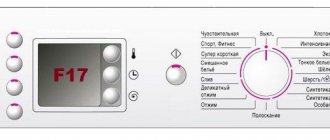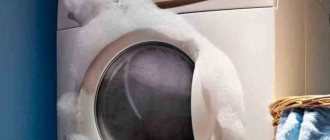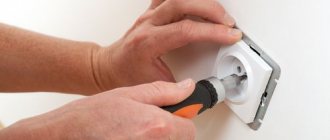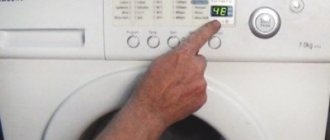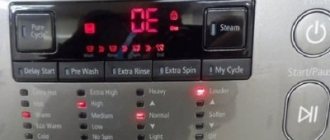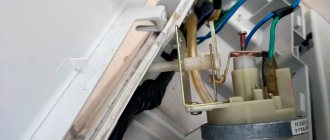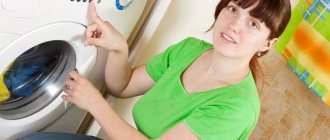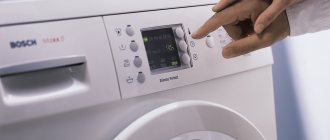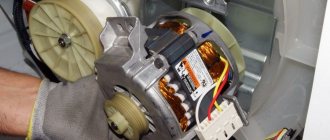When buying a washing machine, study its technical characteristics. Users are most interested in how many programs it contains, what it looks like and how many things can be loaded into the drum, without taking into account other indicators.
These large household appliances are classified according to the following parameters: washing efficiency, spinning, energy consumption. The power inherent in a washing machine is one of the key ones that determines how economical and productive the equipment will be.
Classification of washing machines by energy consumption
To find out how much electricity a device consumes, look at what energy efficiency class it belongs to. For this purpose, there is a letter designation on the label or warranty card: from “A” to “G”. "A" is the most economical option. “G” – costly.
Sometimes there is a “+” sign next to the letter, indicating reduced electrical energy consumption. The most economical household appliances will be those marked “A+++”.
Washing machine power consumption
How much light in watts this technique will “pull” depends on the energy consumption class to which it belongs:
- "A++". Equipment of this class requires less than 0.15 kW/h per 1 kg of laundry;
- "A+". Energy consumption – less than 0.17 kW/h per 1 kg;
- "A". To wash a kilogram of clothes, you need from 0.17 to 0.19 kW/h;
- "B". Consumes 0.19 – 0.23 kW/h per 1 kg;
- "WITH". Approximate light consumption per 1 kg of loaded laundry is from 0.23 to 0.27 kW/h;
- "D". Energy consumption parameter – 0.27 – 0.31 kW/h.
There are also other classes, however, there is no point in considering them, since they are used less and less in the equipment currently produced. The classes coming after “D” consume from 0.31 kW/h per 1 kg of laundry.
How many kW per hour do different models consume?
Electricity prices are constantly rising, so consumers are increasingly purchasing machines with high energy efficiency. Let's consider several models of washing machines of different power with the most economical consumption.
- The LG F12B9LD model is made using direct drive electric motor technology. Class type A, consumption is 1.02 kW per hour.
- Premium device Bosch WAY28790EU. Belongs to the optimal economy type A, consumes 1.31 kW per hour.
- Washing machine HOTPOINT ARISTON AQ114D697DEU/B. There is a function for automatic consumption optimization, classified as type A. Consumes 1.138 kWh
- Narrow device with front loading type INDESIT XWSA610517WUA. 16 washing programs, tank designed for 6 kg of laundry, class A. Consumes 1.006 kW/h.
- Washing machine model LG F80C3LD. Front loading, spin quality class G, and only 0.75 kW per hour per 1 kg. Consumption type A.
- Washing machine Bosch WVH228360OE. Front loading type, has a drying function, the tank holds 7 kg of clothes, electricity consumption class, consumption 5.67 kWh/kg, spin type B.
READ MORE: Electrolux geysers: reviews, model overview, characteristics
Washing machine power consumption
Washing machine control unit
Washing machines are complex multifunctional household appliances that can heat water, wash clothes, spin them and drain the water. There are often models with a “drying” function. Which nodes “pull” the light:
- electric motor;
- heating element;
- pump that drains water;
- Control block.
The motor responsible for rotating the drum and the electric heater (TEH) consume the most electricity, but they operate periodically rather than constantly.
To make a calculation of energy consumption per hour, it is not enough to multiply the “total” watts with time. The power consumption of washing equipment depends on many factors: the number of revolutions of the electric motor, programs, water heating temperature, and drum load.
Electric motor
Washing machine motor
The engine is the main link of this technology. Its function is to rotate the drum. An electric motor is a part that consumes most of the light. The main types of motors found in such devices:
- asynchronous;
- collector;
- brushless.
Two-phase asynchronous motors are no longer installed in new models. Most manufactured devices use inverter commutator or brushless electric motors.
Collector “engines” do not last long, as their brushes wear out.
At the moment, well-known brands such as LG, Samsung, Siemens, Bosch, Indesit and others produce washing machines with brushless electric motors.
This technique “pulls” 20% less light, makes less noise during operation and can operate for about 10 years without replacing parts. The power of these engines is 400 - 800 W.
heating element
Washing machine heating element
The heating element is an element that heats the water in the tank to the temperatures required by the selected program. If the equipment has a powerful heating element, then it will “pull” more light per unit of time.
The average power consumption will not change much, because a powerful heating element will heat up the water faster than a low-power element.
The surface of the heating element may become covered with limescale, which causes the water to take longer to heat up.
At the same time, light consumption will also increase. The problem can be solved simply: pour citric acid into the equipment’s loading tray and run the standard program.
The power inherent in modern heaters is 1.7 - 3 kW.
Drain pump
This part pumps water out of the tank. The pump can operate several times during a wash, depending on the selected mode.
The design itself looks like an impeller rotated by a compact electric motor.
At the inlet, its blades draw in water, and at the outlet, they push it out, from where it flows to the drain hose. Such pumps practically do not draw light, since their power consumption is from 25 to 40 W.
Electronic control unit
Display panel
An important node, including:
- CPU;
- display panel;
- starting capacitors;
- power supply used to obtain low-voltage voltages and other parts.
There are many components in the electronic unit, but the device itself requires virtually no electricity. It only needs 10 - 15 watts.
Device Features
Modern washing machines come in various versions. They differ in models, sizes, power and other indicators.
Depending on the class of the device, the amount of energy it consumes changes. Therefore, you can easily and simply choose the most suitable washing machine.
It will work once or several times a day, while consuming very little electricity.
Electricity costs for washing: what affects?
As practice shows, electricity costs for washing do not have a constant figure. It is quite variable and depends on different indicators. They are mainly related to the technical characteristics of the device. Thus, different parameters can be selected for each wash. This includes mode, time, type of material, etc.
Also, do not forget about the service life of the device. If the washing machine has been in use for a long time, then it is quite logical that scale has accumulated on its heating element. It prevents the water from heating up quickly. As a result, the electricity costs for this process increase significantly.
If we talk about the average value of this indicator, then it is in the range from 0.5 to 4.2 kW/h. This is the amount of electricity consumed by a washing machine. The most economical devices include class A. Only it will allow you to wash clothes with an electricity consumption of no more than 1.5 kW/h.
How much does laundry cost?
Most Russian citizens wash their clothes several times a week. If you count three times, then the monthly electricity costs for this procedure will be 25-35 kW/h. This figure is low. But if you translate it into monetary equivalent, then the amount is impressive.
But even with this calculation, it is not the same for everyone and depends on many factors. The main one has to do with where exactly you live. Since different regions have their own tariff schedule for utility bills. Therefore, it is necessary to calculate, taking into account these data.
How much water does an automatic washing machine consume?
While washing can be done without electricity, it cannot be done without water. Even if you do it with your hands in a basin, without resorting to using a washing machine. Only water will allow you to efficiently remove any dirt from clothing. And, of course, powder or other means.
If we talk about hand washing, then water costs are easy to calculate. Moreover, they will not be tall. But using an automatic washing machine is more difficult. In this case, the costs will be much higher. This is due to many things.
Firstly, you should pay attention to what model of the device it is. If we talk about new ones, then their water consumption is minimal. Therefore, when choosing technology, you should pay attention to this.
Secondly, the amount of laundry that needs to be washed is important. For each washing machine, two concepts are important: maximum drum load and type of wash. As practice shows, it is better to be guided by the former. If you wash in small volumes, but often, more water is consumed.
It is also equally important whether the device is working properly. If the operation of at least one of its elements is disrupted, then water costs will certainly increase. This is especially true for parts such as the intake valve and others.
In addition, before you start washing, it is worth familiarizing yourself with its modes in more detail, since each involves a different use of water. If you give preference to water-intensive modes, then it is logical that this consumption will be high.
And, of course, it is important how the owner treats the work done by the washing machine. If after the end of the procedure she is dissatisfied, then the whole process is repeated. In this case, one rinse is often used. Well, how can you do it without water?
Average water consumption
This indicator is not the same for all devices. The points that influence it were discussed above. The model, manufacturer and technical characteristics of the device are also equally important.
If we draw an analogy, then everyone’s water consumption is different. But what’s good is that you can find out this indicator not only experimentally, but also from the documents that come with the equipment, or rather the passport for the product.
This information is mandatory.
The average water consumption for all washing machines ranges from 39 to 80 liters. Moreover, this amount is required for just one wash. As for the automatic washing machine, today it is approximately 60 liters.
You can monitor this value yourself. Moreover, if you see its increase, then you should immediately pay attention to what and how you are doing. Perhaps there are errors somewhere, or the device has failed. If the problem is the latter, then you need to urgently contact a specialist, he can fix it. Then the water consumption for washing will decrease. You will see this right away.
Despite the significant costs of electricity and water, you should not refuse to use a washing machine. It is better to take the necessary measures to help reduce these indicators. Then the use of such technology will not cause inconvenience.
How to determine the power of a washing machine
Power consumption is calculated in laboratory conditions. Experts estimate how much equipment spends kWh per 1 kg of loaded items. To test any models, equal conditions are taken: a full washing cycle is turned on with a maximum load (usually 5 kg) and a water temperature of +60 degrees.
Cotton items are used as linen. After completing the cycle, the model is assigned a certain energy consumption class.
The simplest method for determining power, without visiting laboratories, is to study the technical characteristics of the model. The power parameter is indicated in the passport or on a label pasted on the case.
Equipment with a “drying” function has its own energy consumption scale. Electrical energy consumption is calculated in the same way as for classical machines.
How many kilowatts does a washing machine consume?
Based on the data described above, the average consumption is as follows:
- 400 - 800 W during washing;
- approximately 2 kW for heating water (the heating element is turned on). There are models that consume about 2900 W.
Light consumption largely depends on the energy consumption class. Drum loading, mode, temperature - all this is reflected in the final figure. According to average data, equipment spends from 0.3 to 1.6 kW/h per cycle.
If you buy large equipment with a “drying” function and a capacious drum for 6–7 kg of laundry, then energy consumption can exceed 1.6 kW/h.
Standard models with a “capacity” of 5 kg per wash require no more than 0.8 kW per hour. In Moscow, the price of 1 kW is 5.38 rubles. It turns out that the price of one wash is 4.3 rubles.
Now for detailed calculations. If the washing machine is turned on three times a week, with three wash cycles per day, then in 12 days this is 36 washes:
- per month. 0.8 x 36 = 28.8 kW/h. Multiply by the tariff (5.38), you get 155 rubles;
- in year. 36 x 12 x 0.8 = 345.6 kW/h = 1838 rubles.
Water use
The amount of water used by the specified equipment during operation is determined by the following factors:
- model - the presence of programs that allow you to save resources;
- degree of loading - with the maximum amount of loaded laundry, the volume of consumption is reduced;
- technical condition - in the presence of certain malfunctions, consumption indicators may increase sharply;
- user demands - many housewives are not satisfied with the quality of washing or rinsing clothes, so sometimes the unit is restarted, which leads to an increase in the amount of resources used.
The average consumption parameters of modern automatic machines range from 0.04 to 0.08 cubic meters per full cycle.
With the intensity of equipment use according to the above calculation, with an average amount of water used per cycle within 0.06 cubic meters, consumption will be:
- per week – 0.06*6=0.36 m³;
- per month - 0.36 * 4 + 0.06 = 1.5 m³ (one wash is added, since there are 3 - 4 days more in a month than 4 weeks).
We recommend: Unauthorized connection to the power grid
With an average cost of one cubic meter of 38 rubles. The monthly payment amount will be 57 rubles.
The final cost of using this equipment per month, excluding the cost of detergents, will be about 132 rubles.
How to save electricity
Scale on the heating element
There are simple rules of economy, adhering to which, equipment will not consume more light than it needs:
- select the appropriate mode. If the laundry only needs to be rinsed, there is no point in setting the temperature to +50 degrees Celsius. Most of the electricity is used to heat the water and spin the clothes at the end of the cycle;
- When choosing a machine, look at its inherent energy efficiency category. The most economical models are marked “A” and “B”;
- If the house has a two-tariff meter, then it is better to run the machine at night. At night the price per 1 kW decreases. It is more convenient if the model has a “delayed start” function;
- The equipment should only be started when enough dirty laundry has collected to load a full drum. You shouldn’t wash one T-shirt at a time, hoping that the washing machine will draw less light. Consumption per cycle does not depend on drum load;
- From time to time you need to clean the heating element from scale. If this is not done, the water will take longer to heat up;
- When washing particularly dirty laundry, instead of putting it in the drum several times, it is better to pre-soak the item in a bowl of warm water and detergent.
The best thing is to carefully monitor things and use them carefully so as not to “put” greasy stains.
The power of large household appliances is indicated in the passport or on a label stuck on the body. Washing machines are divided by energy efficiency class, so it is better to immediately take a closer look at a more “economical” model. It will not be superfluous to follow simple operating rules, which will save treasured kilowatts.
Bosch wll2416eoe
The rigid, vibration-resistant frame design of the device provides stability and quieter sound during operation. The inverter motor reduces noise due to the absence of friction of parts. Externally it looks stylish, with its shape and white body color it will easily fit into any interior. A wide selection of working programs makes it possible to select a mode for washing a certain type of item, be it sportswear or children's clothing, jeans, etc.
| Loading | 6 kg |
| Energy consumption | A |
| Spin efficiency | IN |
| Rotation speed (spin) | 1200 rpm |
| Energy consumption | 0.13 kWh/kg |
Cost from 27,500 to 32,370 rubles.
pros
- laundry reloading function;
- ease of use;
- presence of delayed start;
- suitable for people with sensitive skin;
- possibility to select optimization of washing programs thanks to VarioPPerfect;
- ActiveWater function allows you to choose full or half load;
- quiet;
- the ability to adjust the volume of sound signals, which is good for working at night;
- does not jump;
- after the end of the wash it turns off;
- the display shows all the necessary information;
- child lock;
- good spin;
- accelerated washing mode.
Minuses
- the ultra-sensitive sensor is easy to accidentally touch;
- Locking the keys when washing will not help with children, because... when turning the main handle to the “Off” state the machine turns off, but when turned on it continues to erase from the place where it stopped the cycle;
- the control panel, where there is a touch screen, has a play when pressed with a finger;
- can automatically increase the washing time;
- lack of drying.
Wonderful thing. Before this I had a machine from LG, compared to it the difference is obvious. Doesn't rattle, doesn't knock, washes outerwear, blankets, down jackets well. I started it overnight and by morning everything was ready. Beauty!
READ MORE: How to replace the heating element on a washing machine (Candy or Hoover) watch online video from Vladimir Zemtsov in good quality. — Video hosting Rutube
Bosch WLL2416EOE
